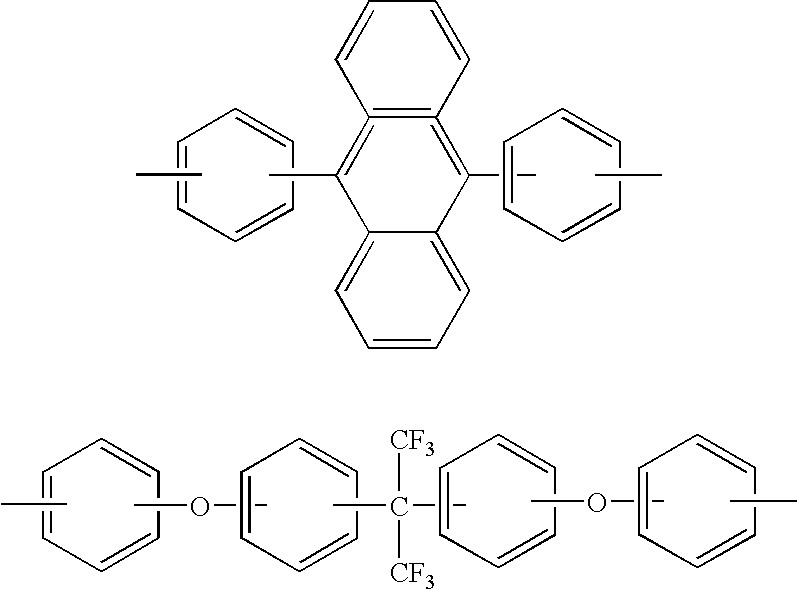Laminate and process for producing the same
a technology of laminates and processes, applied in the field of laminates, can solve the problems of reducing heat resistance and fire retardance, large dimensional change, and dimensional change as obstacles, and achieve the effect of preventing the oxidation of the conductor
- Summary
- Abstract
- Description
- Claims
- Application Information
AI Technical Summary
Benefits of technology
Problems solved by technology
Method used
Image
Examples
synthetic example 1
[0061]In a 1 L separable flask was placed 425 g of DMAc and 23.87 g (112.44 mmol) of DADMB and 10.36 g (28.12 mmol) of BAPB were dissolved in the DMAc with stirring. Thereafter, 40.20 g (136.63 mmol) of BPDA was added to the solution while passing a stream of nitrogen. The mixture was then allowed to polymerize at room temperature for 5 hours with stirring to give a solution of polyimide precursor A which showed an apparent viscosity of 350 poises at 25° C. when measured by an E-type viscometer.
synthetic example 2
[0062]In a 1 L separable flask was placed 425 g of DMAc and 31.53 g (148.37 mmol) of DADMB was dissolved in the DMAc with stirring. Thereafter, 43.21 g (146.87 mmol) of BPDA was added to the solution while passing a stream of nitrogen. The mixture was then allowed to polymerize for 5 hours with stirring to give a solution of polyimide precursor B which showed an apparent viscosity of 361 poises at 25° C. when measured by an E-type viscometer.
synthetic example 3
[0063]In a 1 L separable flask was placed 425 g of DMAc and 35.15 g (165.57 mmol) of DADMB was dissolved in the DMAc with stirring. Thereafter, 7.25 g (16.32 mmol) of 6FDA and 32.04 g (146.89 mmol) of PMDA were added to the solution while passing a stream of nitrogen. The mixture was then allowed to polymerize for 2 hours with stirring to give a solution of polyimide precursor C which showed an apparent viscosity of 280 poises at 25° C. when measured by an E-type viscometer.
PUM
| Property | Measurement | Unit |
|---|---|---|
| temperature | aaaaa | aaaaa |
| size | aaaaa | aaaaa |
| RH | aaaaa | aaaaa |
Abstract
Description
Claims
Application Information
 Login to View More
Login to View More - R&D
- Intellectual Property
- Life Sciences
- Materials
- Tech Scout
- Unparalleled Data Quality
- Higher Quality Content
- 60% Fewer Hallucinations
Browse by: Latest US Patents, China's latest patents, Technical Efficacy Thesaurus, Application Domain, Technology Topic, Popular Technical Reports.
© 2025 PatSnap. All rights reserved.Legal|Privacy policy|Modern Slavery Act Transparency Statement|Sitemap|About US| Contact US: help@patsnap.com



